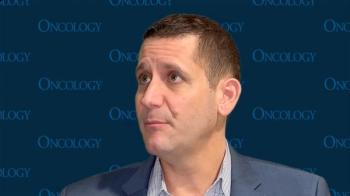
- Oncology Vol 29 No 4_Suppl_1
- Volume 29
- Issue 4_Suppl_1
(P063) Can Some High-Risk Prostate Cancer Patients Be Treated With a Shorter Course of Androgen Deprivation Therapy (ADT)?
This study suggests that certain patients with high-risk prostate cancer may be effectively treated with a shorter course of hormone ablation therapy. Longer follow-up and more patients will be needed to verify the efficacy of a shorter course of hormone ablation therapy in this patient population.
Seungtaek Choi, MD, Quynh-Nhu Nguyen, MD, Sean E. McGuire, MD, PhD, Karen E. Hoffman, MD, MPH, Thomas J. Pugh, MD, Steven J. Frank, MD, Usama Mahmood, MD, Deborah A. Kuban, MD, Andrew K. Lee, MD, MPH; UT MD Anderson Cancer Center
PURPOSE: To determine the efficacy of a shorter course of androgen deprivation therapy (ADT) in patients with high-risk prostate cancer.
MATERIALS AND METHODS: Charts of 472 high-risk prostate cancer (stage ≥ T3a, Gleason ≥ 8, or prostate-specific antigen [PSA] > 20.0 ng/mL) treated between 2000 and 2012 were reviewed. Eighty patients who were treated with a shorter course of ADT (≤ 12 mo of a gonadotropin-releasing hormone [GnRH] agonist) were analyzed for this study. All patients were treated with image-guided radiation therapy with either intensity-modulated radiation therapy or proton therapy. The median total dose given was 76 Gy in 2-Gy fractions (range: 74–86.4 Gy in 1.8–2.0-Gy fractions). Patients were followed with PSA measurements taken at 3–6-month intervals after the radiation therapy. Biochemical failure was defined as nadir + 2 as per the Phoenix definition. Biochemical relapse–free survival and prostate cancer–specific survival were calculated using the Kaplan-Meier method.
RESULTS: Median age was 73 years (range: 52–89 yr). The ADT duration was ≤ 6 months in 18 patients (22.5%) and 9–12 months in 62 patients (77.5%). The distribution of T stage was as follows: 1 patient with TX (1.3%), 31 with T1c (38.8%), 23 with T2a (27.5%), 10 with T2b (12.5%), 5 with T2c (6.2%), 6 with T3a (7.5%), and 5 with T3b (6.2%). The distribution of Gleason scores was as follows: 6 patients (7.5%) with Gleason 7 (3 + 4), 9 (11.2%) with Gleason 7 (4 + 3), 53 (66.2%) with Gleason 8 (4 + 4), 11 (13.8%) with Gleason 9 (4 + 5), and 1 (1.3%) with Gleason 9 (5 + 4). Four patients had PSA < 4 ng/mL (5.0%), 48 patients had PSA 4.1–10 ng/mL (60.0%), 19 patients had PSA 10.1–20 ng/mL (23.8%), and 9 patients had PSA > 20 ng/mL (11.2%). The majority of patients had disease at the lower end of the high-risk spectrum (stage ≤ T2 [85.0%], Gleason ≤ 8 [84.9%], and PSA ≤ 20 ng/mL [88.8%]). Median follow-up was 38 months (range: 3–158 mo). Actuarial 4-year biochemical relapse–free survival was 91%. There were four biochemical failures seen, with a median time to failure of 33.5 months (range: 27–48 mo). There was no significant correlation between T stage, Gleason score, PSA, or duration of hormone ablation therapy and recurrence. Although there were 10 deaths in this patient population, none of the deaths was related to prostate cancer.
CONCLUSIONS: This study suggests that certain patients with high-risk prostate cancer may be effectively treated with a shorter course of hormone ablation therapy. Longer follow-up and more patients will be needed to verify the efficacy of a shorter course of hormone ablation therapy in this patient population.
Proceedings of the 97th Annual Meeting of the American Radium Society-
Articles in this issue
Newsletter
Stay up to date on recent advances in the multidisciplinary approach to cancer.

















































































